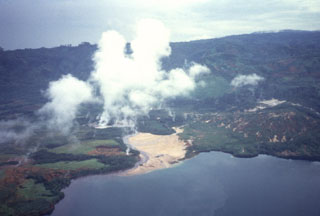Report on Suoh (Indonesia) — 22 May-28 May 2024
Smithsonian Institution / US Geological Survey
Weekly Volcanic Activity Report, 22 May-28 May 2024
Managing Editor: Sally Sennert.
Please cite this report as:
Global Volcanism Program, 2024. Report on Suoh (Indonesia) (Sennert, S, ed.). Weekly Volcanic Activity Report, 22 May-28 May 2024. Smithsonian Institution and US Geological Survey.
Suoh
Indonesia
5.25°S, 104.27°E; summit elev. 1000 m
All times are local (unless otherwise noted)
PVMBG reported that a phreatic eruption at Suoh’s Nirwana Crater occurred at 0830 on 24 May and produced a dense white steam plume; two more phreatic explosions occurred within the following half hour. According to BNPB the first event ejected sediment, the second event ejected sediment-laden water, and the third produced a dense black plume. Loud booming was heard within a radius of several kilometers. During a field visit, scientists noted that pebble-sized material had been ejected and temperatures around the vent were higher. The public was warned to stay 500 m away from Nirwana Crater and to avoid Suah’s craters and associated drainages due to potentially elevated levels of carbon dioxide. Very minor hydrothermal explosions took place in 1994; large phreatic explosions last occurred in 1933.
Geological Summary. The 8 x 16 km Suoh (or Suwoh) depression appears to have a dominantly tectonic origin, but contains a smaller complex of overlapping calderas oriented NNE-SSW. Historically active maars and silicic domes lie along the margins of the depression, which falls along the Great Sumatran Fault that extends the length of the island. Numerous hot springs occur along faults within the depression, which contains the Pematang Bata fumarole field. Large phreatic explosions (0.2 km2 tephra) occurred at the time of a major tectonic earthquake in 1933. Very minor hydrothermal explosions produced two 5-m-wide craters at the time of a February 1994 earthquake.
Sources: Pusat Vulkanologi dan Mitigasi Bencana Geologi (PVMBG, also known as CVGHM), Badan Nacional Penanggulangan Bencana (BNPB)

